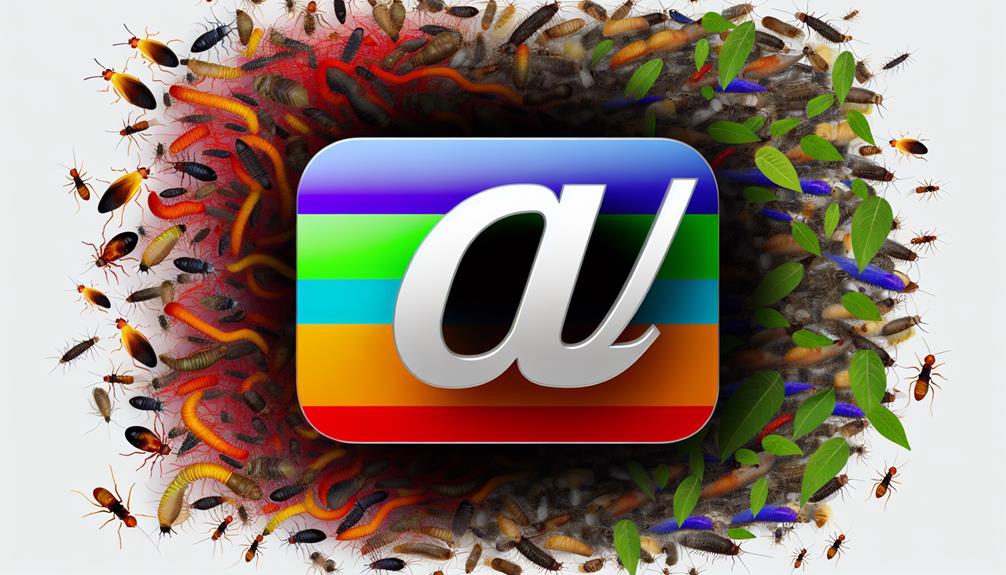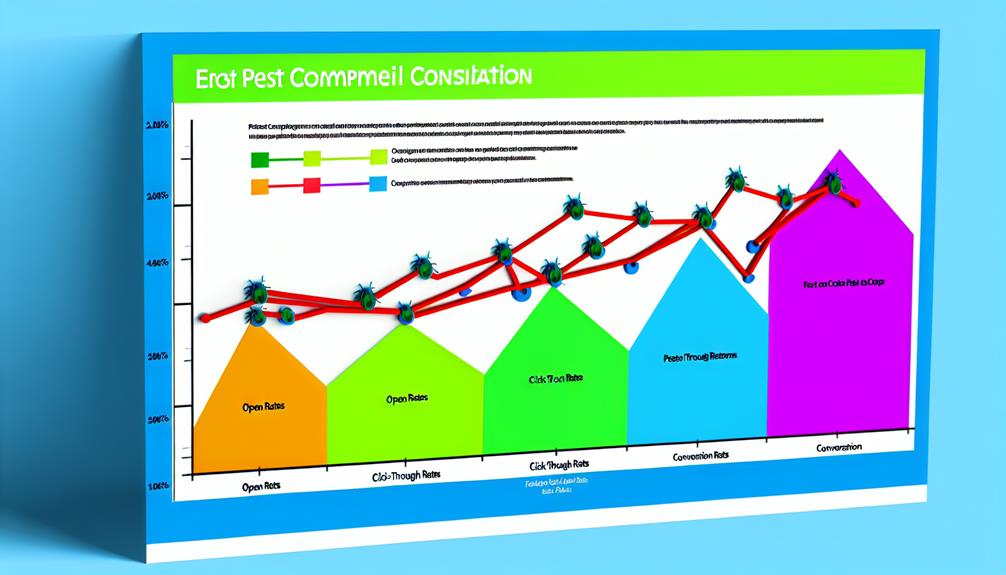Are you tired of losing pest control customers before you even have a chance to showcase your expertise? Well, fret no more because we have 7 proven strategies that will not only engage your customers but also keep them coming back for more.
From building an email subscriber list to analyzing and optimizing email campaign performance, these strategies will revolutionize the way you connect with your customers.
But that’s not all, there’s a secret seventh strategy that will truly blow your mind.
So, are you ready to take your pest control business to the next level?
Table of Contents
ToggleKey Takeaways
- Building and growing an email subscriber list is essential for effective marketing in the pest control industry.
- Crafting compelling email content using storytelling techniques, attention-grabbing subject lines, and clear call to action strategies can greatly engage pest control customers.
- Personalizing email campaigns by using data and insights to create personalized content, implementing segmentation strategies, and addressing customers’ unique concerns can have a maximum impact on pest control customers.
- Implementing automation, segmentation, and A/B testing tactics can save time, improve communication, and provide valuable insights into customer behavior for pest control businesses.
Building an Email Subscriber List

To effectively engage your pest control customers, it’s crucial to build an email subscriber list. In today’s digital age, email marketing is one of the most effective strategies to reach and connect with your target audience. However, with changing email marketing trends, it’s important to stay up-to-date with the best practices for building a strong subscriber list.
One of the first steps in building an email subscriber list is to create compelling and effective subject lines. A subject line is the first thing your customers see in their inbox, and it can determine whether they open your email or not. To capture their attention, your subject lines should be concise, informative, and engaging. Avoid using generic subject lines and instead, personalize them to make your customers feel valued and important.
Additionally, you can offer incentives to encourage your customers to subscribe to your email list. This could include exclusive discounts, helpful tips and advice, or access to educational resources. By providing value to your customers, they’ll be more likely to provide their email addresses and join your subscriber list.
Crafting Compelling Email Content
Craft compelling email content by incorporating engaging storytelling techniques that capture the attention of your pest control customers. One of the most important elements in crafting compelling email content is the subject line. A well-crafted subject line will entice your customers to open your email and read its contents. Make sure to keep it concise, clear, and relevant to the content of your email. For example, you can use subject lines like ‘Get rid of pests for good with our expert tips’ or ‘Say goodbye to pests with our exclusive offer!’ to grab your customers’ attention.
Once your customers open your email, it’s crucial to have a clear call to action strategy. This means providing a specific action that you want your customers to take, such as clicking on a link to learn more or signing up for a special offer. Use strong and persuasive language to encourage your customers to take action. For example, you can say ‘Click here to book your pest control service now and enjoy a pest-free home!’ or ‘Don’t miss out on our limited-time offer, sign up today!’
Crafting compelling email content requires a combination of storytelling techniques, attention-grabbing subject lines, and clear call to action strategies. By following these strategies, you can create emails that engage and convert your pest control customers.
Personalizing Email Campaigns for Maximum Impact

Personalizing your email campaigns is essential for maximizing their impact on your pest control customers. By implementing segmentation strategies and personalization techniques, you can tailor your emails to meet the specific needs and preferences of each customer, increasing their engagement and ultimately driving more conversions.
Segmentation strategies involve dividing your customer base into different groups based on certain criteria such as location, past purchases, or specific pest problems they’ve faced. This allows you to create targeted email campaigns that address their unique concerns and offer relevant solutions. For example, you can send a personalized email to customers in a specific location, highlighting the most common pests in their area and offering tips on how to prevent infestations.
Personalization techniques go beyond simply addressing your customers by their first name. It involves using data and insights to create personalized content that resonates with each individual. This could include recommending specific pest control services based on their previous purchases or sending targeted offers and discounts that align with their preferences.
Implementing Automation and Segmentation Tactics
Now let’s explore how you can enhance your email campaigns by implementing automation and segmentation tactics for optimal customer engagement.
Automation offers several benefits when it comes to pest control customer engagement. By automating your email campaigns, you can save time and resources while ensuring consistent and timely communication with your customers. Automation allows you to set up triggered emails based on specific customer actions or events, such as sending a reminder for a scheduled pest control service or following up after a treatment. This personalized approach helps to keep your customers engaged and informed.
However, implementing segmentation tactics can present challenges. One of the main challenges is gathering accurate and relevant customer data. In order to effectively segment your email campaigns, you need to have a deep understanding of your customers and their preferences. This can involve collecting data on their location, pest issues, past interactions, and preferences. Another challenge is ensuring that your email content is tailored to each segment. This requires creating different email templates and messages that resonate with each specific segment.
Despite these challenges, implementing automation and segmentation tactics can significantly improve your email campaigns’ effectiveness and customer engagement. By personalizing your emails based on customer data, you can deliver targeted and relevant content that resonates with your customers and ultimately drives them to take action.
A/B Testing Strategies for Optimal Results

To optimize your email campaigns, you can employ A/B testing strategies for optimal results. A/B testing allows you to compare two versions of an email, known as variant A and variant B, to determine which one performs better. This testing method can significantly improve your email deliverability and conversion rate optimization.
When conducting A/B testing, it’s essential to focus on one variable at a time. For example, you can test different subject lines, email designs, or call-to-action buttons. By analyzing the results, you can identify the most effective element and incorporate it into future campaigns.
To ensure accurate results, it’s crucial to have a large enough sample size. The more data you collect, the more confident you can be in your conclusions. Additionally, make sure to monitor the testing process regularly and adjust your approach as needed.
When analyzing the results of your A/B tests, pay attention to metrics such as open rates, click-through rates, and conversion rates. These metrics will provide valuable insights into your customers’ behavior and preferences, allowing you to refine your email campaigns for optimal performance.
Nurturing Customer Relationships Through Email Marketing
When it comes to nurturing customer relationships through email marketing, there are a few key points to consider.
First, effective email campaigns are crucial in engaging and retaining customers. By delivering valuable content, personalized offers, and timely updates, you can keep your pest control customers interested and informed.
Second, building customer loyalty is essential for long-term success. By consistently delivering high-quality service and maintaining open lines of communication, you can establish trust and loyalty with your customers, ensuring repeat business and positive referrals.
Effective Email Campaigns
Engage your pest control customers and nurture lasting relationships through effective email campaigns.
When it comes to email design, it’s crucial to create visually appealing and mobile-friendly emails that grab your customers’ attention. Use eye-catching graphics, clear and concise messaging, and a strong call-to-action to encourage engagement.
Additionally, ensure that your emails are optimized for deliverability. This means using a reputable email service provider, maintaining a clean email list, and avoiding spam trigger words.
Personalize your emails by addressing customers by their name and segmenting your email list based on their preferences and behavior.
Building Customer Loyalty
Building customer loyalty is essential for the long-term success of your pest control business. Email marketing can be a powerful tool to nurture and strengthen those relationships. By consistently providing value and maintaining a strong presence in your customers’ inboxes, you can increase customer satisfaction and retention.
Here are three effective strategies for building customer loyalty through email marketing:
- Personalized communication: Use customer data to personalize your emails. Address customers by name and tailor content to their specific needs and preferences. This shows that you value their individuality and enhances their overall experience with your brand.
- Exclusive offers and discounts: Reward your loyal customers with exclusive offers and discounts. This not only makes them feel appreciated but also incentivizes them to continue doing business with you.
- Educational content: Share informative and relevant content with your customers. Provide them with valuable tips and insights related to pest control. This establishes your expertise and positions you as a trusted resource, further strengthening the bond with your customers.
Analyzing and Optimizing Email Campaign Performance

By closely monitoring these metrics, you can identify areas for improvement and make data-driven decisions to enhance your email campaigns.
Additionally, implementing A/B testing techniques can help you understand what resonates best with your customers and further optimize your email campaign performance.
Email Metrics for Success
When analyzing and optimizing the performance of your email campaigns, it’s crucial to focus on the key metrics that provide valuable insights into customer engagement and conversion rates. Here are three important email metrics to consider:
- Email deliverability: This metric measures the percentage of emails successfully delivered to recipients’ inboxes. A high deliverability rate indicates that your emails are reaching the intended audience and not getting caught in spam filters.
- Email open rates: This metric shows the percentage of recipients who open your emails. A higher open rate suggests that your subject lines and email content are compelling and resonating with your audience.
- Click-through rates: This metric measures the percentage of recipients who click on links within your emails. A higher click-through rate indicates that your emails are effectively driving engagement and prompting recipients to take action.
A/B Testing Techniques
To effectively analyze and optimize the performance of your email campaigns, implement A/B testing techniques.
A/B testing involves creating two versions of an email campaign and sending them to different segments of your target audience.
This allows you to identify the most effective elements, such as subject lines, call-to-action buttons, or email layouts, and make data-driven decisions to improve your campaigns.
A/B testing also helps you understand your customers’ preferences and behavior, allowing you to tailor future campaigns to their needs.





